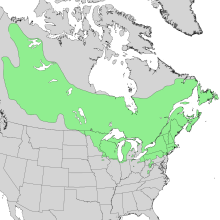Alnus incana
Alnus incana | |
|---|---|
 | |
| Speckled alder Alnus incana subsp. rugosa | |
Scientific classification | |
| Kingdom: | Plantae |
Clade: | Angiosperms |
Clade: | Eudicots |
Clade: | Rosids |
| Order: | Fagales |
| Family: | Betulaceae |
| Genus: | Alnus |
| Subgenus: | Alnus subg. Alnus |
| Species: | A. incana |
Binomial name | |
Alnus incana (L.) Moench[1] | |
 | |
A. incana complete range | |
 | |
A. incana subsp. incana range | |
 | |
A. incana subsp. rugosa range | |
 | |
A. incana subsp. tenuifolia range | |
Alnus incana, the grey alder or speckled alder, is a species of alder with a wide range across the cooler parts of the Northern Hemisphere.
Contents
1 Description
2 Subspecies
3 Ecology
4 Chemistry
5 Uses
6 References
7 Further reading
Description
It is a small- to medium-sized tree 15–20 m (49–66 ft) tall with smooth grey bark even in old age, its life span being a maximum of 60 to 100 years. The leaves are matte green, ovoid, 5–11 cm (2–4 1⁄4 in) long and 4–8 cm (1 1⁄2–3 1⁄4 in) broad. The flowers are catkins, appearing early in spring before the leaves emerge, the male catkins pendulous and 5–10 cm (2–4 in) long, the female catkins 1.5 cm (5⁄8 in) long and one cm broad when mature in late autumn. The seeds are small, 1–2 mm (0.04–0.08 in) long, and light brown with a narrow encircling wing. The grey alder has a shallow root system, and is marked not only by vigorous production of stump suckers, but also by root suckers, especially in the northern parts of its range. The wood resembles that of the black alder, but is somewhat paler and of little economic value.

Alnus incana var. tenuifolia male flowers in early spring along the Columbia River
Subspecies
There are four to six subspecies, some treated as separate species by some authors:
Alnus incana subsp. incana (grey alder).—Northern Europe and northwestern Asia, and central and southern Europe in mountains, mainly in the regions of the Alps, Carpathians and the Caucasus.
Alnus incana subsp. hirsuta (Spach) Á. & D.Löve (=A. hirsuta Spach); Manchurian alder.—In mountains of Northeast Asia and Central Asia.
Alnus incana subsp. kolaensis (N.I.Orlova) Á. & D.Löve.—Subarctic northeast Europe.
Alnus incana subsp. oblongifolia (=Alnus oblongifolia); Arizona alder.—Madrean Sky Islands of southwestern North America, in Arizona, New Mexico, and Northwestern Mexico.
Alnus incana subsp. rugosa (Du Roi) R.T.Clausen (=A. rugosa Du Roi); speckled alder.—Much of Canada below the tree line, and the Northeastern United States.
Alnus incana subsp. tenuifolia (Nutt.) Breitung (=A. tenuifolia Nutt.); mountain alder, or thinleaf alder.—Western North America, including New Mexico to California and Alaska.[2][3][4]
Ecology
Alnus incana is a light-demanding, fast-growing tree that grows well on poorer soils. In central Europe, it is a colonist of alluvial land alongside mountain brooks and streams, occurring at elevations up to 1,500 metres (4,900 ft). However, it does not require moist soil, and will also colonize screes and shallow stony slopes. In the northern part of its range, it is a common tree species at sea level in forests, abandoned fields and on lakeshores. It is sometimes used for afforestation on non-fertile soils which it enriches by means of nitrogen fixing bacteria in its root nodules. Several species of Lepidoptera use grey alder as a food plant for their caterpillars. See List of Lepidoptera that feed on alders. In the boreal forest area of Canada, A. incana is often associated with black spruce in the forest type termed black spruce–speckled alder.[5]
Chemistry
Pedunculagin is an ellagitannin found in the Manchurian alder (A. hirsuta var. microphylla).[6]
Uses
The tree is cultivated in parks and gardens. The cultivar 'Aurea' has gained the Royal Horticultural Society's Award of Garden Merit.[7]
The Zuni people use the bark of the tenuifolia subspecies to dye deerskin reddish brown.[8]
References
^ Flora of North America 2009.
^ Jepson Flora Project (ed.). "Alnus incana subsp. tenuifolia". Jepson eFlora. The Jepson Herbarium, University of California, Berkeley. Retrieved January 28, 2013..mw-parser-output cite.citation{font-style:inherit}.mw-parser-output q{quotes:"""""""'""'"}.mw-parser-output code.cs1-code{color:inherit;background:inherit;border:inherit;padding:inherit}.mw-parser-output .cs1-lock-free a{background:url("//upload.wikimedia.org/wikipedia/commons/thumb/6/65/Lock-green.svg/9px-Lock-green.svg.png")no-repeat;background-position:right .1em center}.mw-parser-output .cs1-lock-limited a,.mw-parser-output .cs1-lock-registration a{background:url("//upload.wikimedia.org/wikipedia/commons/thumb/d/d6/Lock-gray-alt-2.svg/9px-Lock-gray-alt-2.svg.png")no-repeat;background-position:right .1em center}.mw-parser-output .cs1-lock-subscription a{background:url("//upload.wikimedia.org/wikipedia/commons/thumb/a/aa/Lock-red-alt-2.svg/9px-Lock-red-alt-2.svg.png")no-repeat;background-position:right .1em center}.mw-parser-output .cs1-subscription,.mw-parser-output .cs1-registration{color:#555}.mw-parser-output .cs1-subscription span,.mw-parser-output .cs1-registration span{border-bottom:1px dotted;cursor:help}.mw-parser-output .cs1-hidden-error{display:none;font-size:100%}.mw-parser-output .cs1-visible-error{font-size:100%}.mw-parser-output .cs1-subscription,.mw-parser-output .cs1-registration,.mw-parser-output .cs1-format{font-size:95%}.mw-parser-output .cs1-kern-left,.mw-parser-output .cs1-kern-wl-left{padding-left:0.2em}.mw-parser-output .cs1-kern-right,.mw-parser-output .cs1-kern-wl-right{padding-right:0.2em}
^ "Alnus incana ssp. tenuifolia". Calflora: Information on California plants for education, research and conservation, with data contributed by public and private institutions and individuals, including the Consortium of California Herbaria. Berkeley, California: The Calflora Database – via www.calflora.org.
^ "Alnus incana". Plants for a Future. Retrieved January 28, 2013.
^ Hogan 2008.
^ Lee, O.; Choi, M.; Ha, S.; Lee, G.; Kim, J.; Park, G.; Lee, M.; Choi, Y.; Kim, M.; Oh, C. H. (2010). "Effect of pedunculagin investigated by non-invasive evaluation on atopic-like dermatitis in NC/Nga mice". Skin Research and Technology. 16 (3): 371–377. doi:10.1111/j.1600-0846.2010.00443.x. PMID 20637007.
^ "RHS Plantfinder - Alnus incana 'Aurea'". Royal Horticultural Society. 2012. Retrieved 5 January 2018.
^ Stevenson, Matilda Coxe (1915). "Ethnobotany of the Zuni Indians". SI-BAE Annual Report. 30: 80.
Further reading
"Alnus incana". Flora Europaea. Edinburgh: Royal Botanical Garden. 2008.
Furlow, John J. (2009). "Alnus incana". In Flora of North America Editorial Committee. Flora of North America North of Mexico (FNA). 3. New York and Oxford – via eFloras.org, Missouri Botanical Garden, St. Louis, MO & Harvard University Herbaria, Cambridge, MA.
Hogan, C. Michael (2008). Stromberg, N., ed. "Black Spruce: Picea mariana". GlobalTwitcher.com. Archived from the original on 2011-10-05.
"Alnus incana - information, genetic conservation units and related resources". European Forest Genetic Resources Programme (EUFORGEN).